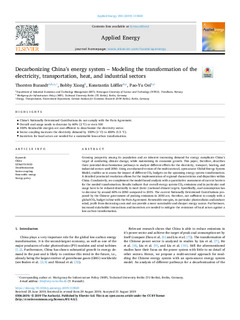| dc.contributor.author | Burandt, Thorsten | |
| dc.contributor.author | Xiong, Bobby | |
| dc.contributor.author | Löffler, Konstantin | |
| dc.contributor.author | Oei, Pao-Yu | |
| dc.date.accessioned | 2019-09-12T07:41:13Z | |
| dc.date.available | 2019-09-12T07:41:13Z | |
| dc.date.created | 2019-09-11T15:35:23Z | |
| dc.date.issued | 2019 | |
| dc.identifier.citation | Applied Energy 2019, 255 (113820), | nb_NO |
| dc.identifier.issn | 0306-2619 | |
| dc.identifier.uri | http://hdl.handle.net/11250/2616468 | |
| dc.description.abstract | Growing prosperity among its population and an inherent increasing demand for energy complicate China’s target of combating climate change, while maintaining its economic growth. This paper, therefore, describes three potential decarbonization pathways to analyze different effects for the electricity, transport, heating, and industrial sectors until 2050. Using an enhanced version of the multi-sectoral, open-source Global Energy System Model, enables us to assess the impact of different CO2 budgets on the upcoming energy system transformation. A detailed provincial resolution allows for the implementation of regional characteristics and disparities within China. Conclusively, we complement the model-based analysis with a quantitative assessment of current barriers for the needed transformation. Results indicate that overall energy system CO2 emissions and in particular coal usage have to be reduced drastically to meet (inter-) national climate targets. Specifically, coal consumption has to decrease by around 60% in 2050 compared to 2015. The current Nationally Determined Contributions proposed by the Chinese government of peaking emissions in 2030 are, therefore, not sufficient to comply with a global CO2 budget in line with the Paris Agreement. Renewable energies, in particular photovoltaics and onshore wind, profit from decreasing costs and can provide a more sustainable and cheaper energy source. Furthermore, increased stakeholder interactions and incentives are needed to mitigate the resistance of local actors against a low-carbon transformation. | nb_NO |
| dc.language.iso | eng | nb_NO |
| dc.rights | Navngivelse 4.0 Internasjonal | * |
| dc.rights.uri | http://creativecommons.org/licenses/by/4.0/deed.no | * |
| dc.title | Decarbonizing China’s energy system – Modeling the transformation of the electricity, transportation, heat, and industrial sectors | nb_NO |
| dc.type | Journal article | nb_NO |
| dc.type | Peer reviewed | nb_NO |
| dc.description.version | publishedVersion | nb_NO |
| dc.source.volume | 255 | nb_NO |
| dc.source.journal | Applied Energy | nb_NO |
| dc.identifier.doi | https://doi.org/10.1016/j.apenergy.2019.113820 | |
| dc.identifier.cristin | 1723736 | |
| dc.description.localcode | © 2019 The Author(s). Published by Elsevier Ltd. This article is available under the terms of the Creative Commons Attribution License (CC BY). You may copy and distribute the article, create extracts, abstracts and new works from the article, alter and revise the article, text or data mine the article and otherwise reuse the article commercially (including reuse and/or resale of the article) without permission from Elsevier. | nb_NO |
| cristin.unitcode | 194,60,25,0 | |
| cristin.unitname | Institutt for industriell økonomi og teknologiledelse | |
| cristin.ispublished | true | |
| cristin.fulltext | original | |
| cristin.qualitycode | 1 | |

